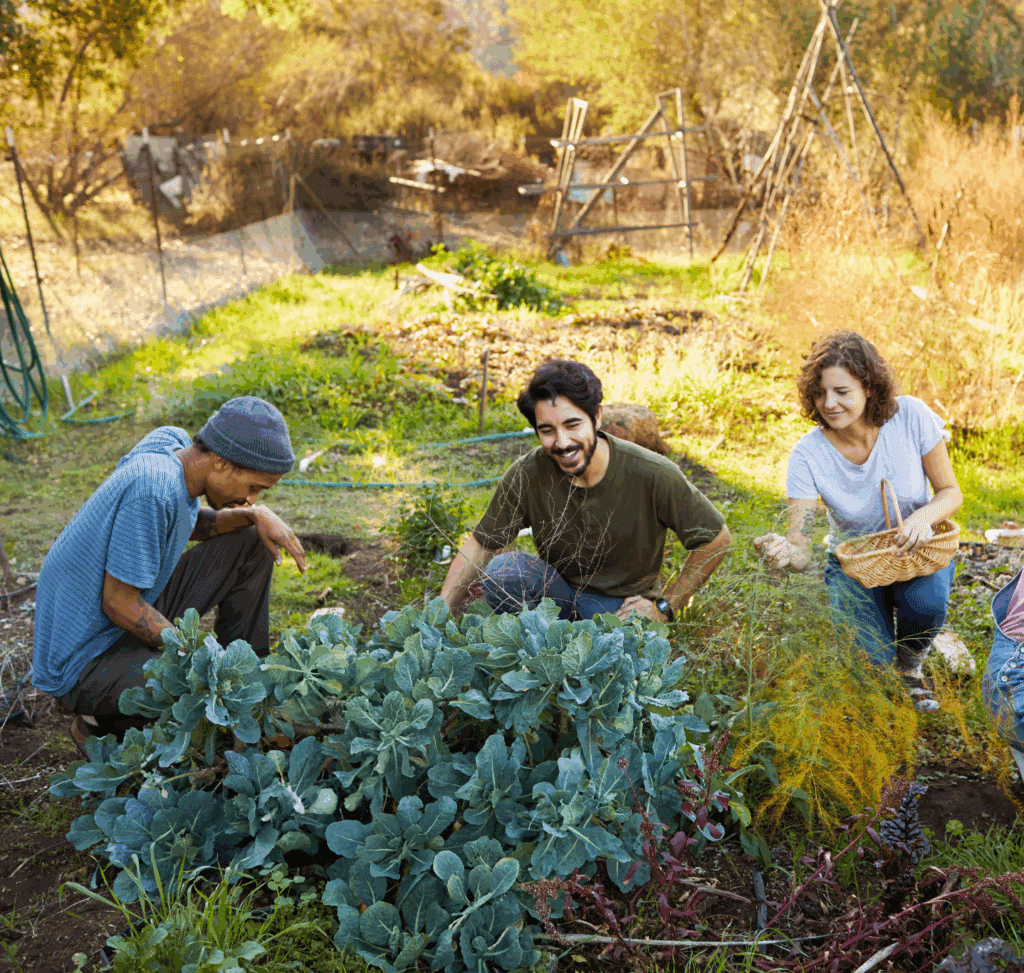Therapeutic Gardening Activities for Groups in Mental Health Settings

For those of us managing mental health difficulties, the shared experiences associated with gardening may improve our emotional wellbeing by reducing feelings of isolation and loneliness. Therapeutic gardening projects can also offer us a renewed sense of purpose and enjoyment, which can be lacking in our lives when we feel lost, down, depressed, or anxious.
Group horticultural therapy activities can include a wide variety of nature-based interventions. Each activity is tailored to the individual, helping each person improve their well-being on their terms.
On this page, we will look at:
What therapeutic group gardening is- The science behind nature-based group interventions
- How group gardening works
- Examples of different gardening therapy group activities
- How to overcome challenges in group settings
- How Mission Connection can support you

What Is Therapeutic Group Gardening?
Gardening is the practice of planting, growing, and caring for flowers and vegetable plants outdoors. It encompasses a range of activities, such as:
- Planting seeds
- Digging earth
- Trimming
- Weeding
- Harvesting
- Watering
Therapeutic group gardening, also known as horticultural therapy, refers to structured gardening activities that are done in a group setting and designed to improve mental and physical health and wellbeing. Benefits of group gardening may include:
- Helping people to build social connections through horticulture
- Giving a sense of purpose and belonging
- Teaching fun and important skills for life
- Encouraging collaboration and teamwork
- Promoting positive and healthy behaviors
But how? Let’s explore the science behind gardening and mental health.
The Science Behind Gardening and Mental Health
Additionally, around a third of adults in the US do not eat a healthy diet. Fast food and convenience options have made some of us lose our connection with the food we eat. We forget where it comes from or how it comes into being.4
Growing produce (including fruits, vegetables, and herbs) in the garden may improve our connection with food and remind us of the journey from plant to plate. We might also start to feel connected to the part we play in planting, cultivating, and caring for our food. The desire to sample our own home-grown goods may encourage us to enjoy more healthy and varied options in our diet.
Furthermore, gardening activities get us out in the fresh air and sunshine. These can be an enjoyable way to do some physical activity in the outdoors as an alternative to traditional exercise or sport. This makes gardening especially suitable for older people or those with mobility issues.
How Group Gardening Therapy Works
Group gardening and therapeutic garden activities for adults use the principles of therapeutic horticulture to deliver structured therapy sessions out in nature. Therapeutic horticulture activities should be delivered by a trained mental health professional who is also experienced in gardening and outdoor activities.
During group gardening therapy, tasks and activities will be planned out. Sessions will be conducted in regular intervals – often weekly – to offer a consistent, safe, and predictable space. These services are typically offered for people with physical, or mental health difficulties or learning disabilities who are in need of therapeutic support.
Group sessions will involve a small group of people who work together in a garden setting. Each person is encouraged to engage at their own pace, in a way that feels comfortable for them. They’re also encouraged to interact with others within their group.
Structuring a Mental Health Gardening Program
If you are planning out team gardening for emotional healing, stress relief or mental health support, we highly recommend structured gardening activities. These offer a sense of safety and predictability, which can help encourage processing and healing.
Before starting therapeutic group gardening, it’s important to ask yourself:
How to make activities accessible to a wide range of skills and abilities- How the program could be adapted if a client is struggling to participate due to a mental or physical issue
- Alternative plans for bad weather or low turnout
- How you’ll map out sensible, measurable objectives to test how well the therapy is working and the progress your clients are making
- Ways to make the activities varied and fun
- Potential feedback from your clients and ways to adapt to their needs, preferences, or recovery rates
One of the most beneficial aspects of group gardening therapy is that it creates a sense of belonging in participants. But for belonging to take place successfully, the environment needs to be physically and emotionally safe (Rebeiro 2001).5 So, this is another important factor to bear in mind. Appropriate outdoor spaces may include communal allotments, hospital gardens, or a private outdoor space in a residential facility.
Examples of Therapeutic Gardening Group Activities
Some examples of therapeutic gardening activities that people enjoy include:
-
Planting and sowing flowers, plants, fruits, or vegetables together: The act of planting or sowing seeds together can help participants work together with a cohesive goal in mind. Planting may help us to access our caring and nurturing side as well as provide a sense of purpose and accomplishment.- Harvesting and preparing food together: A healthy, balanced diet is essential for our health and well-being. Harvesting and preparing food together encourages collaboration and cohesion. Cooking and preparing produce from the therapeutic garden, such as fruits, vegetables, and herbs, may even encourage us to try new foods!
- Sampling produce from the garden together and mindful eating: Mindful eating can help to activate the senses and lets us savor the moment and be present, without judgment. Research suggests that mindful eating is beneficial to both our physical and mental health. It can also help us to understand and connect with our food and make healthier choices.6
- Art-based horticultural therapy activities: Creative and art-based ideas include flower pressing, making collages, painting, or journaling. Creative activities in the garden may provide moments of quiet reflection, inspire creativity, or help us to express difficult emotions or feelings. Art therapy has been shown to be a powerful tool that can help with mental health recovery as part of a holistic treatment plan.7
- Caring for the garden together: Caring for the garden together can help develop our own nurturing side and inspire an emotional connection between ourselves and others, as well as the earth. The act of caring for the plants and flowers may also inspire self-care and self-compassion.
- Activities to encourage group mindfulness in the garden: Mindfulness is a technique that teaches us a special type of mental focus, allowing us to focus fully on the present moment. Group mindfulness activities may include group meditation, mindful weeding, or mindful art activities, such as coloring.
- Sensory activities: Sensory activities incorporate some, or all, of the five senses: Taste, touch, sight, smell, and sound. Sensory play stimulates the brain and improves cognitive function, and may also help with improving emotional regulation.8 Sensory activities can be incorporated into group gardening for stress relief in the herb garden or in aromatherapy-based activities.
Overcoming Challenges in Group Gardening Therapy
Group therapy sessions may present challenges due to a number of factors, for example:
- People within the group have different levels of skill or ability
- Tensions may arise between group members due to personality clashes
- Satisfying everyone’s varied interests may be difficult
- The participant’s goals may not align with the planned activities
Group garden therapy may be additionally challenging if the participants have especially complex mental health needs. This is why this type of group therapy requires careful planning and should only be done under the instruction of a trained mental health professional.
Creating a calm and safe space for participants may help to reduce any tension or problems in group therapy. Effective communication and a culture of mutual respect can also help with group cohesion. Tensions and problems can be used as an opportunity to learn problem-solving skills, which can help us learn and grow emotionally and spiritually.
Other challenges may arise due to:
- The weather: For example, heavy rain, heat waves, severe wind, or other challenging weather that could make outdoor activities difficult or dangerous.
- Physical challenges: Such as pain from kneeling for a long time or problems with access.
- Issues around funding: It may be difficult to cover the cost of therapeutic outdoor experiences.
- Keeping participants interested: Participants not being committed or losing interest in the project.
Solutions to some of the above challenges include designing activities carefully, having a back-up plan, and using outdoor spaces that are accessible and welcoming to all, regardless of age or disability. If resources or funding become a barrier to running outdoor workshops, you could consider fundraising. You could also check whether any financial help is available from either the government or charity organisations.
Group Gardening Therapy Support at Mission Connection
At Mission Connection, we are here to support you as you deal with mental health challenges or heal from trauma. We understand how horticultural therapy can be used in a group setting as part of a holistic treatment plan to help you with issues such as depression or anxiety.
We offer a variety of holistic treatments, including therapeutic group gardening, to support your mental health. If you or a loved one needs support with your mental health, please contact us today. Our highly experienced, professional advisors will keep anything you tell us in the strictest confidence.

References
- Mushtaq, R., Shoib, S., Shah, T., & Mushtaq, S. (2014). Relationship between loneliness, Psychiatric Disorders and Physical health ? A review on the psychological aspects of loneliness. JOURNAL OF CLINICAL AND DIAGNOSTIC RESEARCH. https://doi.org/10.7860/jcdr/2014/10077.4828
- Lee, M., Lee, J., Park, B., & Miyazaki, Y. (2015). Interaction with indoor plants may reduce psychological and physiological stress by suppressing autonomic nervous system activity in young adults: a randomized crossover study. Journal of PHYSIOLOGICAL ANTHROPOLOGY, 34(1). https://doi.org/10.1186/s40101-015-0060-8
- Van Den Berg, A. E., & Custers, M. H. (2010). Gardening Promotes Neuroendocrine and Affective Restoration from Stress. Journal of Health Psychology, 16(1), 3–11. https://doi.org/10.1177/1359105310365577
- Liu, J., & Mozaffarian, D. (2024). Trends in diet quality among U.S. adults from 1999 to 2020 by race, ethnicity, and socioeconomic disadvantage. Annals of Internal Medicine, 177(7), 841–850. https://doi.org/10.7326/m24-0190
- Rebeiro, K. L. (2001). Enabling occupation: the importance of an affirming environment. Canadian Journal of Occupational Therapy, 68(2), 80–89. https://doi.org/10.1177/000841740106800204
- Powell, J. (2025, May 1). Mindful eating – the nutrition source. The Nutrition Source. https://nutritionsource.hsph.harvard.edu/mindful-eating/
- Shukla, A., Choudhari, S. G., Gaidhane, A. M., & Syed, Z. Q. (2022). Role of art therapy in the Promotion of Mental Health: A Critical review. Cureus. https://doi.org/10.7759/cureus.28026
- Scanlan, J. N., & Novak, T. (2015). Sensory approaches in mental health: A scoping review. Australian Occupational Therapy Journal, 62(5), 277–285. https://doi.org/10.1111/1440-1630.12224
